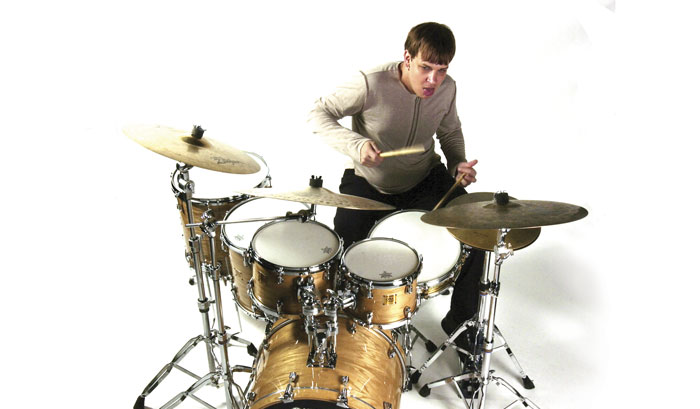


As the sole drummer on Steely Dan's new album, Everything Must Go, Keith Carlock took over one of the most coveted drum thrones in pop music. How did it feel to claim the seat once occupied by legendary players such as Steve Gadd, Rick Marotta, and Hal Blaine?
"It was a pretty amazing experience," says Carlock. "Most pop these days doesn't emphasize that kind of jazz-type drumming. It's a fusion of a lot of different elements, like jazz harmonies and bebopsounding horn lines, but they make it sound like pop music. It's groove music, which is what I'm drawn to as a drummer."
It's a fusion of a lot of different elements, like jazz harmonies and bebop-sounding horn lines, but they make it sound like pop music.
Walter Becker and Donald Fagan, aka Steely Dan, provided Carlock with simple drum-machine demos indicating the desired groove for each song. Carlock's job in the studio was to breathe life into these basic ideas, trying out different tempos and humanizing the parts. "It's a much more organic sound than the previous Steely Dan record [1997's Two Against Nature]," he comments. "We did more live, organic takes of songs. It's a bit more like their older stuff in that respect."

When he's not drumming with Steely Dan, Carlock's primary musical focus is a trio led by guitarist Wayne Krantz, another occasional Steely Dan sideman. Carlock has played with Krantz and bassist Tim Lefebvre for six years at New York City jazz venues and on the European jazz festival circuit. "I've played on two records with these guys so far," he says. "Before I joined the trio, their sound was more structured, but now it's pretty open and improvisational."
Carlock has been playing a Yamaha Maple Custom Absolute kit and recently got a set of oak Customs as well. "I fell in love with them-I'm using them for the Steely Dan tour," he says. "The oak is a harder wood than maple, and there's so much more sound coming out. They have a nice warm tone like the maples, but with more power, projection, and bite. They really carry in louder live situations. You don't feel like you have to bash your brains out just to hear it coming back."
Though Carlock has a healthy collection of Yamaha snares, at heart he's a one-snare man. "My baby is the Yamaha brass piccolo I've had for more than 10 years," he says. "I've used it for everything- almost every recording I've ever done, plus live situations. I'm one of those guys, once I find a snare drum it's hard to move away from that. Sure, if artists or producers want a deeper sound, I have several maple and birch Yamahas, plus an oak one, and they all sound amazing. It's just that I'm into the crack of that piccolo. It's more versatile than people think. For example, I don't always tune it up so it sounds like a piccolo. If you tune it down, it still has a lot of meat, and it records so well. I used it on the whole Steely Dan record. It has a great rim shot, and I just like the way it feels. When I play it seems like there's less air moving around inside the drum."
Any secret drum tricks he's reeled in over the years? "Well," says Carlock, "I'm not a gearhead as far as mic placement and so forth, but in the studio it seems like drums often sound better tuned a little lower than what you're used to live. It adds warmth and bottom end. You don't have to hit as hard. Playing lighter and not choking the instrument seems to sound better in the studio. And for club work, I like to tune the bass drum way down. I don't mic it or stuff it with pillows-I like to get that deep, resonant, ambient sound."
Carlock, who will make his touring debut with Steely Dan this year, looks forward to the challenge of playing drum parts made famous by some of the greatest drummers of the last 30 years. "I'm checking out the old records," he says, "songs like 'Peg' and 'Gaucho.' I won't know 'til rehearsal exactly what I'll do, whether I'll replicate those parts or make it a little bit new."
























